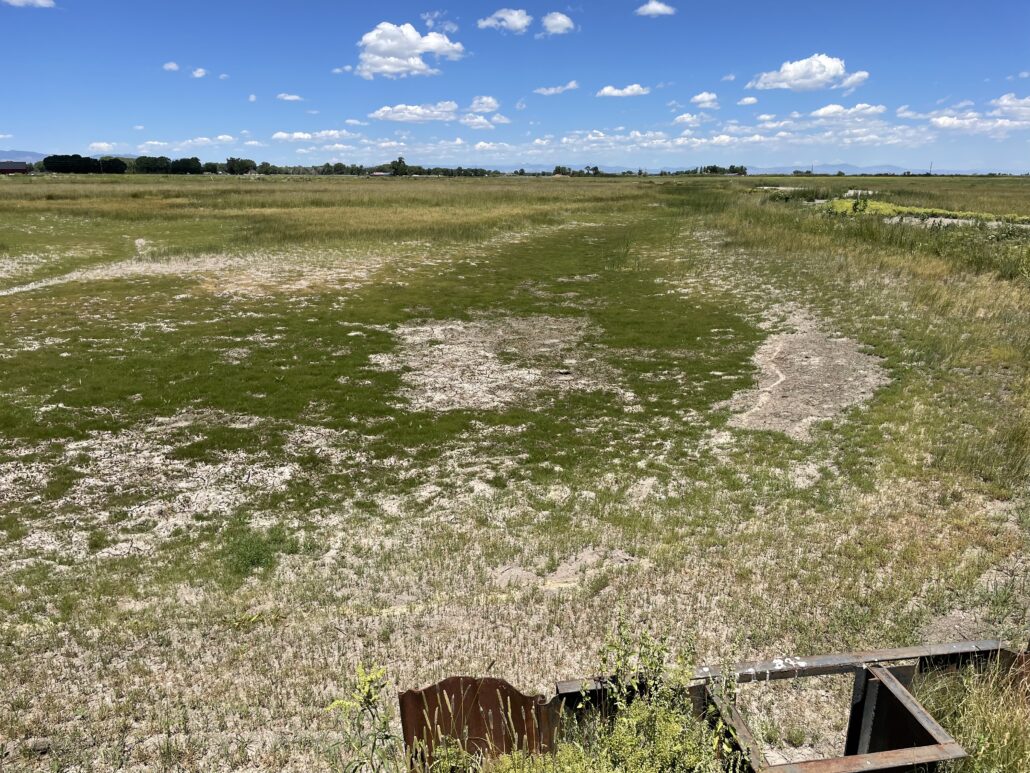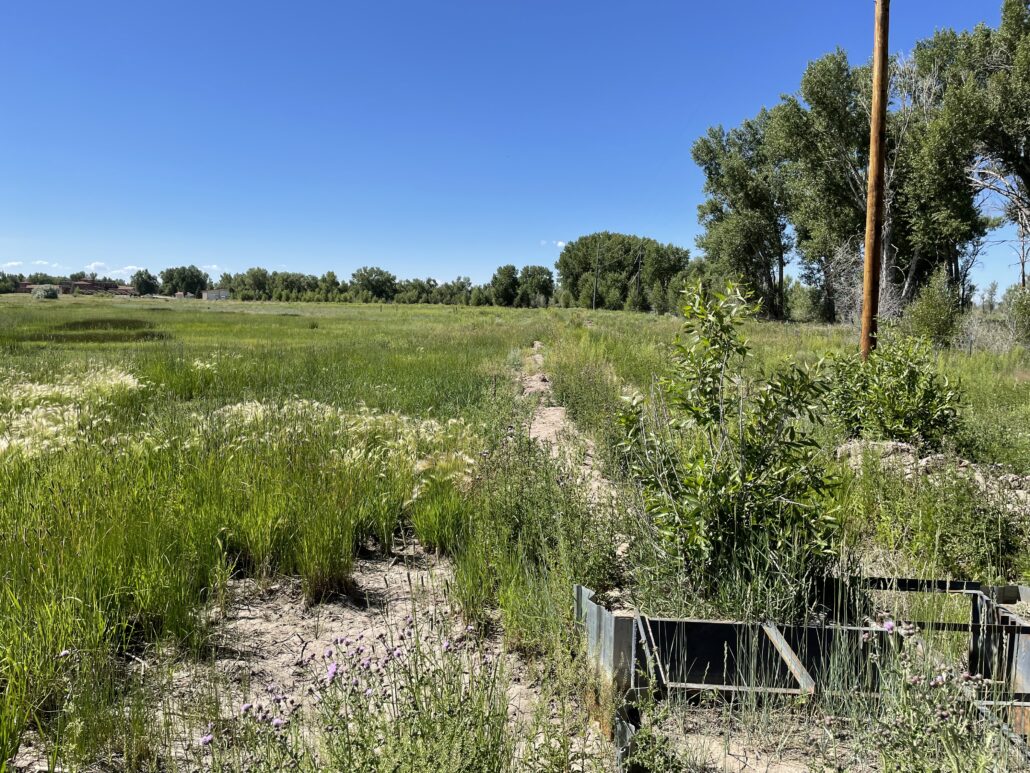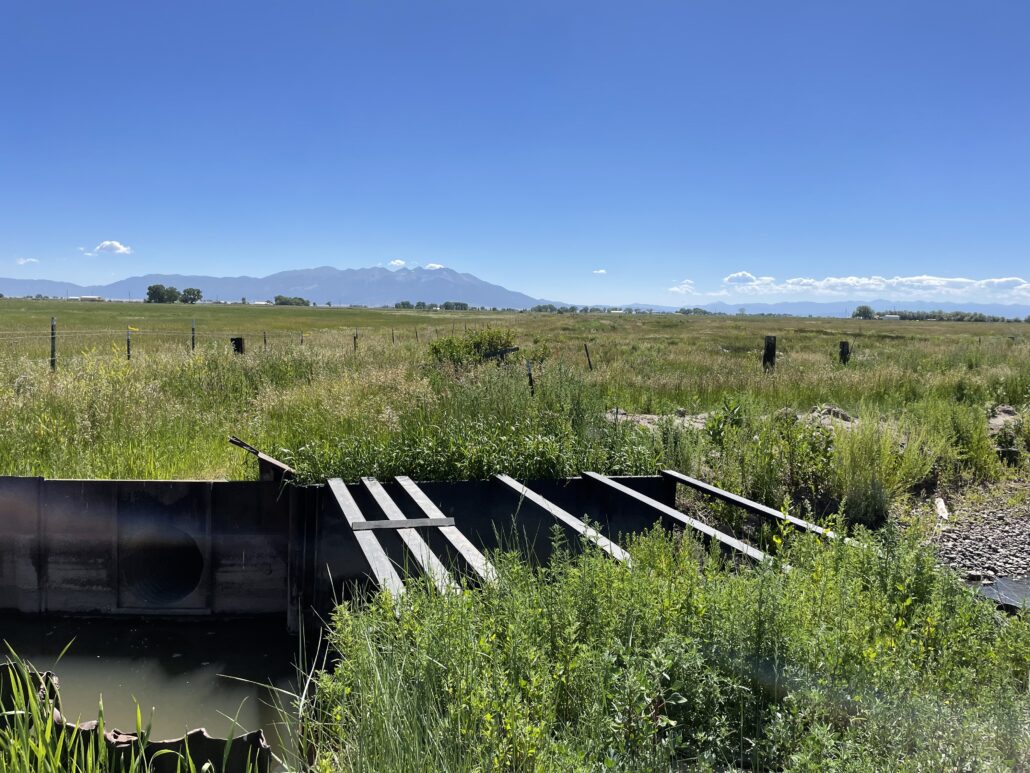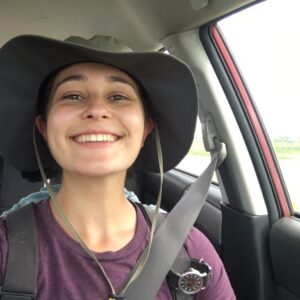In Colorado’s San Luis Valley (SLV), every drop of water is spoken for. Agencies across the state track streamflow, snowpack, irrigation water delivery, and water rights violations. Water in the west is “use or lose it”: if irrigators aren’t ready when water reaches their property, they can’t take it and store it until they are ready; they have to let it keep flowing to the next person. Water administrators have their work cut out for them ensuring water is delivered to the right people, at the right time, in the right quantities, and that everyone using it is following the rules. As the realities of climate change are imminent, including prolonged and more severe drought and water scarcity, tracking water has become even more essential. But, essential for whom?

A classic metal check structure used to build wetland habitat along earthen levees when closed. When open, water flows overland.
Take an irrigation ditch as an example. In the SLV and around the state, these relatively shallow and narrow trenches move water from rivers to farms and ranches for use on the land. A large metal diversion structure sits in a river at the mouth of a ditch channel. When open, this structure (headgate) allows water to run down the ditch to reach the water users, like farmers and ranchers, with rights to it. In most cases in the SLV, these ditches are earthen channels. The soil or gravel make-up of these ditches allow some ground water connectivity, supporting wetland-like systems in adjacent low-lying areas and riparian-like vegetation. In other words, these ditches act like mini river systems and can provide habitat for wetland and riparian species. However, that ground water infiltration can be thought of in another way: as water loss. The water that seeps into the sides of the ditch channel, flowing laterally through the soil only to pop out a few dozen feet away in a low spot to support a few frogs and maybe a duck, is water lost from that ditch. It’s water that doesn’t reach the water user. It’s water that someone has a reliance on that they’ll never receive.
The water users that rely on earthen ditches are perfectly within their right to install a conveyance pipeline or to line the channel walls with concrete to reduce seepage losses. These actions, in turn, would reduce the habitat generated/sustained by those ditch channels and that seepage. This isn’t a discussion of who has more right to that water, the irrigator, or the ducks. It’s an introduction to discussions that have already begun and will only become more common as water becomes scarcer.

A ditch “turnout” structure; this metal box is shaped like a T and can funnel water through the ditch or block the ditch off to send water out into the adjacent field.
So, what is a conservationist to do? On the one hand, water rights holders need the water to sustain their livelihoods, families, and heritage. On the other hand, conveyance losses, like that seepage in an earthen channel, support hundreds of acres of valuable wildlife habitat, subsequently supporting overall watershed health and habitat connectivity. One avenue is to increase the on-farm efficiencies for water use: replace old leaking structures, manipulate topography so water flows more slowly on the surface to increase saturation, add soil moisture sensors so that irrigators can stop the moment they hit the ideal soil wetness. Ultimately, conservationists need to be proactively thinking about how to make water use efficient and go as far as possible. But, as water becomes scarcer, will these alternatives be enough?

A large check structure in the channel of a large irrigation canal. These structures can be used to direct water from the canal down smaller field ditches.
There’s no simple answer. Most irrigators in the SLV love wildlife, and thus wildlife habitat, on their properties. Most wildlife and watershed advocates understand that irrigators need the water to survive, and that farmers and ranchers are conservationists first and foremost. Collaboration and communication throughout the watershed is essential to solving complex conservation challenges like this is one. The good news is there are some good examples already at work in the SLV. The
Rio Grande Basin Roundtable is a board made up of irrigators, water administrators, recreation advocates, wildlife conservationists, and municipal water users. The Roundtable board frequently encounters requests for funding or letters of support for projects with conflicting priorities. For example, a ditch in San Luis, CO requested funds to install a pipeline in a section of a very leaky earthen ditch to reduce leakage and increase water delivery to users. The leaky ditch, however, supports a healthy stand of cottonwood trees and willow shrubs, and the pipeline would sever that groundwater infiltration out of the ditch and lead to a decline in this vegetation. After a long discussion, with wildlife advocates and water administrators going head-to-head for their opposing priorities, it was determined the nearby creek channel likely provided enough groundwater infiltration to keep some of that vegetation going, even with the pipeline. Plus, once that water reaches the user’s fields, it would indirectly support similar vegetation, as well as habitat for waterfowl, cranes, and shorebirds. It was a trade-off, with everyone’s interests represented at the table. It’s these conversations, that will become more common, more challenging, and more emotional, that reinforce the value of every drop counted.
 Anna Greenberg is the Wetland Program Manager in our Stewardship Team. Learn more about our Stewardship program HERE!
Anna Greenberg is the Wetland Program Manager in our Stewardship Team. Learn more about our Stewardship program HERE!
All photos taken by author.



 Anna Greenberg is the Wetland Program Manager in our Stewardship Team. Learn more about our Stewardship program HERE!
Anna Greenberg is the Wetland Program Manager in our Stewardship Team. Learn more about our Stewardship program HERE!

